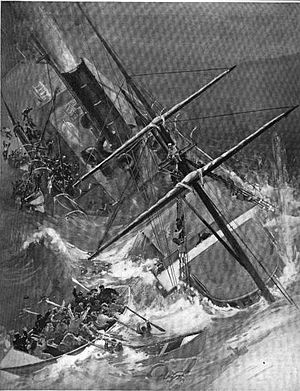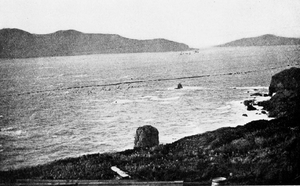SS City of Rio de Janeiro facts for kids

Rio de Janeiro in 1898
|
|
Quick facts for kids History |
|
|---|---|
| Name | City of Rio de Janeiro |
| Operator |
|
| Route | San Francisco to Honolulu, Hawaii, Yokohama, Japan and Hong Kong |
| Builder | John Roach & Son, Chester, Pennsylvania |
| Launched | 6 March 1878 |
| Fate | Sank 22 February 1901, San Francisco Bay |
| General characteristics | |
| Tonnage | 3500 |
| Length | 370 ft (110 m) |
| Beam | 39 ft (12 m) |
| Draft | 21 ft (6.4 m) |
| Depth | 31 ft 6 in (9.60 m) |
| Propulsion | 6 boilers, compound engine, single screw |
| Sail plan | Barquentine rig |
|
|
|
| NRHP reference No. | 88002394 |
| Added to NRHP | 11 November 1988 |
The SS City of Rio de Janeiro was a large steam-powered passenger ship built with an iron hull. It was launched in 1878 and sailed across the Pacific Ocean, connecting San Francisco with different ports in Asia. On February 22, 1901, the ship tragically sank after hitting a hidden reef as it entered San Francisco Bay. It was on its way back from Hong Kong. Out of about 220 people on board, fewer than 85 survived, meaning 135 people lost their lives. The ship's remains now rest 287 feet (87 m) deep in the water near the Golden Gate. It is recognized as an important historical site on the National Register of Historic Places.
The City of Rio de Janeiro was one of many ships that were lost in this area because of the difficult conditions for sailing.
Contents
The Ship's Journey: A Look at Its History
The City of Rio de Janeiro was launched on March 6, 1878. It was first built for a company called the United States & Brazil Mail Steamship Company. This company had only two ships and sailed between Brazil and the United States.
Changing Hands and Routes
Since the Brazil route was not making money, the ship was sold in 1881 to the Pacific Mail Steamship Company. It was then made into an ocean liner, a ship that carries passengers on long journeys. Its new route was between its home port in San Francisco and places like Honolulu, Hawaii, Yokohama, Japan, and Hong Kong.
Notable Events During Service
In 1893, Alfred Daniel Jones, who was the US Consul General in Shanghai (a top US official), died on board. He had been very sick and needed to be held in restraints before he passed away.
In March 1896, the ship ran out of coal while sailing from San Francisco to Hawaii. To keep moving, the crew had to burn parts of the ship, like its wooden masts and deckhouses, as fuel. In 1898, the US Government rented the ship for a short time. It was used to carry soldiers to Manila in the Philippines during the Spanish–American War. After the war, the ship went back to its usual Pacific route.
The Tragic Sinking of the City of Rio de Janeiro
On February 22, 1901, the City of Rio de Janeiro was trying to sail through the Golden Gate into San Francisco Bay. There was a very thick fog. The ship hit rocks, likely near Fort Point, and quickly began to sink.
Why the Ship Sank So Fast
The collision caused huge damage to the ship's bottom, tearing it open. Seawater rushed into the cargo areas and engine room very quickly. The ship was built in 1878, before ships commonly used special walls called watertight bulkheads to stop water from spreading. Because of this, the ship sank in less than ten minutes. The wreck was later found 287 feet (87 m) deep.
There was a lot of confusion on board because the ship's officers spoke English, but many of the Chinese seamen did not. This made it hard to launch lifeboats, and only a few were put into the water.
Rescue Efforts and Survivors
The disaster happened very fast and in the dense fog. The lookout at the Lifesaving Station at Fort Point, which was only a short distance away, did not know about the sinking for two hours. They only found out when a lifeboat appeared out of the fog. Luckily, Italian fishermen were nearby and were able to rescue people clinging to pieces of the ship. One of these brave rescuers, Gaspare Palazzolo, received a gold medal for his heroism.
Out of 210 people on board, 82 were saved, but 128 people died. The ship's captain, William Ward, was among those who died. He had once said that if his ship was ever in danger, he would go down with it. Among the lost was Rounsevelle Wildman, the US Consul General from Hong Kong, along with his wife and two children. They were traveling to Washington DC for the inauguration of William McKinley.
Soon after the City of Rio de Janeiro sank, the United States Congress approved money to build a lighthouse on Mile Rocks, where the sinking happened. A bell buoy had been placed there earlier, but strong currents often pulled it underwater or made it drift away.
What Was on Board: The Ship's Cargo
After the shipwreck, rumors spread that the ship was carrying a lot of gold and silver. However, the ship's official list of cargo, called its manifest, did not show any gold or silver. The manifest did list 2,423 slabs of tin, with each slab weighing 107 pounds (49 kg). The ship's insurance company paid $79,000 for the lost tin. This amount would be worth more than $2,900,000 today.
Searching for the Wreck: Salvage Attempts
Divers hired by the Pacific Mail Line immediately started looking for the ship. However, they could not find it because the water was too deep for the diving and salvage tools of that time.
For several years after the disaster, bodies from the wreck washed up on the beach near Fort Point. In July 1902, the remains of Captain Ward were found and identified by his watch chain.
Early Discoveries and Challenges
On November 15, 1905, a newspaper reported that divers had found the wreck. They were sure it was the City of Rio de Janeiro. One diver almost died while exploring the bottom of the Golden Gate.
In 1917, a wooden keg clearly marked Rio de Janeiro floated to the surface near Point Lobos. In 1919, more wreckage from the ship appeared off Suisun Bay, which is 40 miles (64 km) away from where the ship was thought to have sunk.
Near Baker Beach, the ocean currents are very strong, and the water is too deep for anyone but professional divers. Some people think the currents might have pulled the ship out to sea as it sank. Others believe it is hard to find because there are so many other shipwrecks on the seabed in that area. Even with modern sonar, it might be impossible to tell the City of Rio de Janeiro apart from the remains of other sunken ships.
Modern Searches and Findings
In 1931, a Captain Haskell claimed he had found the wreck using a special two-man submarine he invented. He planned to recover $6 million worth of silver from the ship. However, he disappeared in July 1931 without a trace.
In 1987, Gus Cafcalas, a banker from San Francisco, announced that he and four others had found the wreck the previous fall. They used sonar and photos from a robot submarine. The wreck was in 200 feet of water, half a mile west of the Golden Gate Bridge. Cafcalas said they would not try to raise the ship because its condition and the strong tides made it almost impossible. But they hoped to search inside the ship for the rumored silver cargo.
Cafcalas and his partners tried to get a permit to salvage the ship. However, they did not meet the conditions, and their permit was canceled. The wreck of the Rio de Janeiro was found again in November 2014 and detailed images were taken using sonar. There are currently no plans to salvage it.
- .



